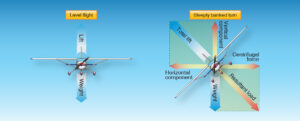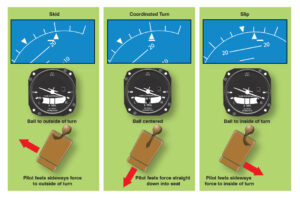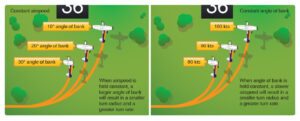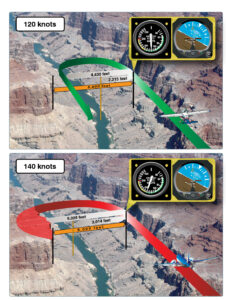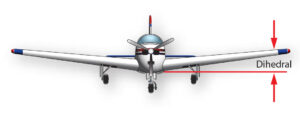Turns in an airplane may seem like a simple maneuver, but how well do you really understand the aerodynamics? Pilots should understand the principles of adverse yaw, coordinated turns, and overbanking tendencies to fly safely in various flight configurations. Mastering these concepts at the start of your training ensures that more complex maneuvers are less of a challenge.
Lift and its Vector Components
An aircraft in flight is always generating some amount of lift, and the total sum of all lift vectors is often perpendicular to the aircraft’s flight path. However, in a level turn, lift is split into two primary vector components: the horizontal component and vertical component. These components are inversely proportional. When the bank angle increases, the horizontal component of lift increases, but the vertical component decreases. Because the vertical component of lift decreases as the bank angle increases, the pilot needs to increase back elevator pressure, which increases the angle of attack, to compensate for the decrease in upward lifting force, allowing the aircraft to maintain altitude in a turn.
Coordinate with the Rudder
Many pilots tend to ignore the rudder pedals, especially during a turn. This is a dangerous practice that is not only uncomfortable and inefficient but also unsafe. The main purpose of the rudder is to keep the aircraft coordinated. Coordination in every phase of flight is profoundly important. Flying uncoordinated during an approach when turning from base to final can cause the aircraft to enter into a spin. Because the aircraft is low and slow during this phase of flight, recovery is unlikely, resulting in an accident. Pilots must learn to fly with coordinated control inputs to prevent unintentional loss of control when maneuvering in certain situations.
How can you tell if you’re flying coordinated? You may feel it in the seat of your pants, but you’ll definitely see it on your instruments. Look at the ball of the turn coordinator (or brick in a glass panel) and keep it centered. Remember the phrase “step on the ball,” meaning press the rudder pedal on the side the inclinometer is deflected. When the ball is opposite the direction of the turn, the aircraft is in a skid; the pilot may feel as though (s)he is being pushed sideways, outside of the turn. Alternatively, when the ball is in the same direction of the turn, the aircraft is in a slip; the pilot may feel as though (s)he is being pushed inside of the turn. Remaining in these configurations can be dangerous. It increases drag, which reduces the range of the aircraft, and, in a high-wing aircraft, can even cause fuel to be drawn unequally from the tanks.
Adverse Yaw
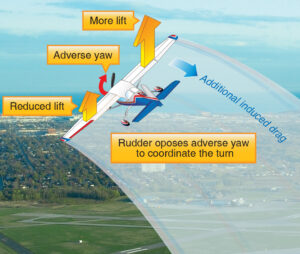 Staying coordinated during straight and level flight is not often a concern, since lift is generated equally on both wings. However, deflecting the ailerons to increase or decrease the bank angle creates a phenomenon known as adverse yaw. The lowered wing produces less lift than the lifted wing due to the change in each wing’s angle of attack. The increased lifting force on the rising wing also causes more induced drag. For example, when banking to the left, induced drag increases on the right wing, which tends to cause the airplane’s nose to turn right.
Staying coordinated during straight and level flight is not often a concern, since lift is generated equally on both wings. However, deflecting the ailerons to increase or decrease the bank angle creates a phenomenon known as adverse yaw. The lowered wing produces less lift than the lifted wing due to the change in each wing’s angle of attack. The increased lifting force on the rising wing also causes more induced drag. For example, when banking to the left, induced drag increases on the right wing, which tends to cause the airplane’s nose to turn right.
Basic aerodynamics tells us that when more lift is generated, more drag is also created. As such, the lifted wing does not only have more lift, but also more drag. This causes the aircraft to turn away from the direction of the turn—also known as a slip.
To combat this, pilots should always be aware of the presence of adverse yaw during a turn and compensate by using appropriate rudder pressure. Remember to “step on the ball” during a turn; i.e., if the ball is swinging left, step on the left rudder pedal, and vice versa.
Rate vs. Radius of Turn
The rate of turn of an aircraft is, in general, the amount of time it takes to complete a turn. The rate of turn at any given airspeed depends on the horizontal component of lift. As mentioned previously, as the angle of bank increases, the horizontal component of lift increases as well. Therefore, the rate of turn at a given airspeed increases as the angle of bank increases. Note that the airspeed is fixed while the angle of bank varies.
On the other hand, when turning at a higher airspeed at a given bank angle, the inertia is greater, causing the turning rate to slow down and therefore increase the radius of turn, as depicted in the figure below. Note here that the airspeed varies while the bank angle remains fixed.
Overbanking Tendency
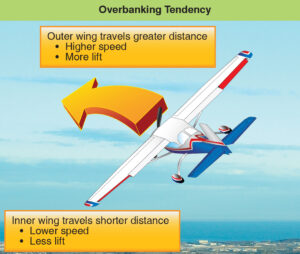 As the angle of bank in a turn becomes steeper, the airspeed over each wing begins to vary greatly. This is because the outer wing travels a longer path than the inner wing, yet both complete their turns in the same amount of time. Therefore, the outer wing travels at a faster airspeed than the inner wing and, as a result, develops more lift. This creates an overbanking tendency that must be controlled by the use of the opposite aileron when the desired bank angle is reached. You will often experience this while performing steep turns. Once you set the steep bank angle, the aircraft will feel as though it wants to roll even further.
As the angle of bank in a turn becomes steeper, the airspeed over each wing begins to vary greatly. This is because the outer wing travels a longer path than the inner wing, yet both complete their turns in the same amount of time. Therefore, the outer wing travels at a faster airspeed than the inner wing and, as a result, develops more lift. This creates an overbanking tendency that must be controlled by the use of the opposite aileron when the desired bank angle is reached. You will often experience this while performing steep turns. Once you set the steep bank angle, the aircraft will feel as though it wants to roll even further.
Manufacturers typically design aircraft with positive static stability, which allows the airplane to return to a straight and level flight on its own. The most common design feature contributing to this stability is the obvious dihedral shape. When the aircraft is banked, the higher wing is at a steeper bank relative to the horizon, which tends to make it fall down.
These are the must-know aerodynamics associated with turns. To learn more about the flight maneuvers required to become a pilot, check out the Gleim Flight Maneuvers and Practical Test Prep for the certificate or rating you are seeking. These books provide step-by-step instructions for all required flight maneuvers to train for your pilot certificate in accordance with the FAA Airman Certification Standards, plus a complete discussion of the common errors for each maneuver.
Written by Ryan Jeff (CFI, AGI), Aviation Research Assistant, and Paul Duty (CFI, CFII, MEI, AGI), Chief Instructor


